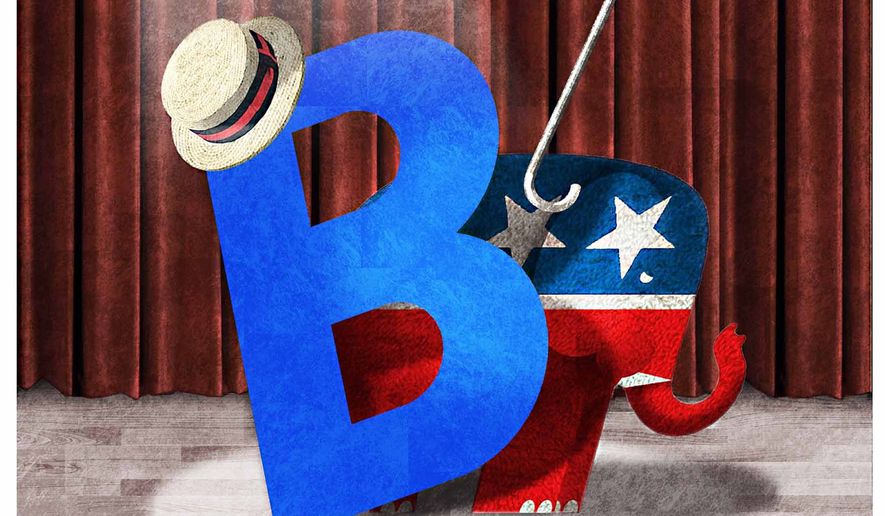OPINION:
The economy and the polls have been delivering both good and bad news to President Biden lately, but Republicans have more to worry about than he does.
Inflation has moderated, jobs growth remains robust, and other basic measures of business activity are generally positive. But voters give Mr. Biden little credit and don’t have much confidence in his ability to manage the nation’s economy.
It’s simple: Economic conditions are better, but not better enough.
In 2022, the year the nation shook off COVID restrictions, real household income fell for the third year in a row, and the negative trend in real wages continued until May of this year.
Inflation persists. The consumer price index is up 3.7% over the past year.
Gasoline and housing are getting more expensive. At grocery stores, inflation has moderated, but beef prices are jumping — especially for steak.
If you like chicken wings, fish sticks and hamburger, you can get along, but sirloin is mostly out except for the high-tech workers and bankers benefiting from the rush into artificial intelligence and higher interest rates.
“Bidenomics” has three pillars: redirecting the economy away from fossil fuels to wind and solar power and electric vehicles; national security by ensuring machinery suppliers to those industries and semiconductor manufacturing are domiciled in America; and social justice by directing benefits to previously disenfranchised minorities and shoring up unions.
Green energy is proving more expensive than advertised. In Texas, for example, voters are being asked to approve special funding to subsidize the construction of natural gas generating plants to back up the state’s green power when the wind does not blow and peak demand exceeds what the sun can provide.
State-subsidized fossil fuel electricity to back up federally subsidized wind and solar!
Most of the costs of wind and solar power are upfront. Those don’t require ongoing fuel purchases and employ fewer workers. But they are also capital intensive.
Green energy makes more economic sense when interest rates were low, but rates are likely to stay high. Some offshore wind projects are being abandoned. Regulators are reluctant to approve higher rates to cover higher financing costs.
We either pay for green energy with higher utility rates, tax to subsidize it, or as is currently the policy, Washington borrows to underwrite green energy and EVs.
Prior to the pandemic, the budget deficit was less than $1 trillion; it’s likely to be $1.6 trillion this year and keep growing. That pushes interest rates up and drives inflation.
Big deficits and too much demand are important reasons the labor markets remain out of balance.
The ratio of job-seekers to the unemployed is about 1.5. In the golden decade before COVID when inflation was tame, the ratio was much lower, and in 2019, it was just 1.2.
An analysis by former Federal Reserve Chairman Ben Bernanke and Olivier Blanchard at the Peterson Institute indicates the ratio would have to dip well below 1.2 to get to 2% inflation.
The last time the nation faced such an inflation challenge, then-Fed Chairman Paul Volcker moved more quickly to raise interest rates.
Chairman Jerome Powell has reasons to go more slowly. A lot of commercial real estate and corporate debt is coming up for renewal this year and through 2027, and the more the Fed pushes interest rates up, the greater the likelihood for more regional bank failures and corporate bankruptcies.
But going slowly causes inflation expectations to harden. Let’s take two measures.
The Conference Board’s measure of consumers’ one-year inflation expectations has been stuck around 5.8% for months. The New York Fed’s measure has been reasonably stable, around 3.6%.
The average is 4.7%, just a bit higher than the current 4.3% pace of core inflation.
Americans don’t expect things to get better.
The benefits of Mr. Biden’s programs are rifle shot. Workers putting up new semiconductor plants or who belong to a union are looking forward to bigger paydays — UPS drivers, airline employees and soon autoworkers.
Unions represent only 6% of private sector workers, and most voters are not riding the gravy train.
The polls indicate that former President Donald Trump could get as many votes as Mr. Biden in a rematch or at least significantly narrow the president’s 2020 popular vote margin.
Mr. Trump’s pickups, however, tend to be among minority voters in red states he won in 2020 and in deep blue states where Mr. Biden’s 2020 advantage is too large to erase completely. Swing voters in battleground states seem to be willing to hang with the president.
Republican obsessions with abortion and cultural issues and Mr. Trump’s legal problems make him even less appealing than Mr. Biden in states such as Pennsylvania, Wisconsin and Michigan.
The economy could tank or voter sentiment further sour on Mr. Trump. But as things stand now, Mr. Biden would prevail in a rematch.
• Peter Morici is an economist and emeritus business professor at the University of Maryland, and a national columnist.




Please read our comment policy before commenting.